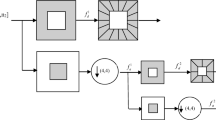Abstract
Fusion of multiple exposure images has attracted attention over the past decade and several algorithms have been developed, so as to capture the entire dynamic range of the scene in a single image. Capturing images with changes in exposure settings leads to a set of multiple exposure images with different areas of the scene highlighted in different image. Weak edges and fine textures of the image are lost during an under or over exposure. Also for objective evaluation we need to measure and both the structural and textural information in the images simultaneously. To address this issue an algorithm based on the Non-subsampled shearlet transform (NSST) for fusing multiple exposure images is proposed so as to depict clearly the dimly lit, brightly lit and well lit regions in a single fused image. In the proposed algorithm NSST decomposition is first performed on the images to obtain the multi-scale and multi-direction representations. The high frequency bands are fused by retaining the pixels with the highest value coefficients at each sub band at each level. Whereas the low frequency bands are fused by averaging operation. Proposed method leads to better results in visual quality.










Similar content being viewed by others
References
Mertens T, Kautz J, Van Reeth F. Exposure fusion: a simple and practical alternative to high dynamic range photography. Comput Gr Forum. 2009;28(1):161–71.
Shanmuganathan Raman, Subhasis Chaudhuri. Low dynamic range solutions to the high dynamic range imaging problem. J Meas Sci Instrum. 2010;1(1):32–6.
Bouridane AAA, Milligan P. Walsh-Hadamard transforms for signal processing. IEEE Trans Circuits Syst. 2001;II(148):377–83.
Chiorean L, Vaida MF. Medical image fusion based on discrete wavelet transform using Java technology. In: Proceedings of the ITI 2009 31st International Conference on Information Technology Interfaces. IEEE; 2009, p. 55–60.
Amia F, Kuala S, Aceh B. Multi-focus image fusion using discrete wavelet transform. In: IEEE Transactions Circuits System II, Analog Digital Signal Process. IEEE; 2009. p. 718–726.
Zhang Q. Multifocus image fusion using the nonsubsampled contourlet transform. Signal Process. 2009;89(7):1334–46 Elsevier.
Quan S, Qian W, Guo J, Zhao H. Visible and infrared image fusion based on curvelet transform. In: The 2014 2nd International Conference on Systems and Informatics (ICSAI 2014). IEEE; 2014. p. 828–832.
Yang Y, Tong S, Huang S, Lin P. Multifocus image fusion based on NSCT and focused area detection. IEEE Sens J. 2014;15(5):2824–38 IEEE.
Zhang N, Wang P, Zong X. A novel peripheral enhancement framework for CT and MRI image fusion in NSST domain. J Med Imaging Health Informat. 2018;8(5):891–9 American Scientific Publishers.
Liu Xingbin, Mei Wenbo, Du Huiqian, Bei Jiadi. A novel image fusion algorithm based on nonsubsampled shearlet transform and morphological component analysis. Signal Image Video Process. 2016;10(5):959–66.
Yang J, Wu Y, Wang Y, Xiong Y. A novel fusion technique for CT and MRI medical image based on NSST. In: 2016 Chinese Control and Decision Conference (CCDC). IEEE; 2016. p. 4367–4372.
Raman S, Chaudhuri S. Bilateral filter based compositing for variable exposure photography. In: Eurographics (short papers); 2009. p. 1–4.
Mantiuk R, Kim KJ, Rempel AG, Heidrich W. HDR-VDP-2: a calibrated visual metric for visibility and quality predictions in all luminance conditions. ACM TOG. 2011;30(4):1–14.
Acknowledgements
We would like to thank Tom Mertens, Jan Kautz and Frank Van Reeth for providing us with code of Exposure Fusion algorithm and also with the set of multiple exposure house images in Fig. 1. We would like to thank the CAVE Computer Vision Laboratory, Columbia University for making available the multiple exposure images from their database shown in Figures, Figs. 5 and 8.
Author information
Authors and Affiliations
Corresponding author
Ethics declarations
Funding
No funding sources
Conflict of interest
The authors declare that they have no conflict of interest.
Ethical approval
This article does not contain any studies with human participants or animals performed by any of the authors.
Additional information
Publisher's Note
Springer Nature remains neutral with regard to jurisdictional claims in published maps and institutional affiliations.
Rights and permissions
About this article
Cite this article
Ramakrishnan, V., Pete, D.J. Non Subsampled Shearlet Transform Based Fusion of Multiple Exposure Images. SN COMPUT. SCI. 1, 326 (2020). https://doi.org/10.1007/s42979-020-00343-4
Received:
Accepted:
Published:
DOI: https://doi.org/10.1007/s42979-020-00343-4




